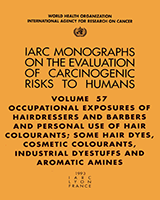NCBI Bookshelf. A service of the National Library of Medicine, National Institutes of Health.
This volume provides a detailed assessment of the carcinogenic risk to humans posed by the professional and personal use of hair colourants. An additional 17 monographs evaluate the carcinogenicity of eight hair dyes, one cosmetic colourant, four industrial dyestuffs, and four aromatic amines, three of which are used in dyestuff manufacture.
The first and most extensive monograph considers the carcinogenic risk posed by occupational exposures of hairdressers and barbers and personal exposure to hair colourants. Citing consistent evidence from five large European cohort studies of excess risk for cancer of the urinary bladder in male hairdressers and barbers, the monograph concludes that occupation as a hairdresser or barber entails exposures that are probably carcinogenic. The carcinogenic risk linked to the personal use of hair colourants could not be determined.
Of the eight hair dyes considered, only one, HC Blue No. 1, could be classified as possibly carcinogenic to humans. The cosmetic colourant, D&C Red No. 9 (CI Pigment Red 53:1), could not be classified. Of the four industrial dyestuffs, CI Direct Blue 15, CI Acid Red 114, and magenta containing CI Basic Red 9 were classified as possibly carcinogenic to humans. The manufacture of magenta was classified as entailing exposures that are carcinogenic.
Of the four aromatic amines, 4,4'-methylene bis(2-chloroaniline) (MOCA) was classified as probably carcinogenic to humans. para-Chloroaniline and 2,6-dimethylaniline were classified as possibly carcinogenic; N,N-dimethyl-aniline could not be classified.
Contents
- NOTE TO THE READER
- LIST OF PARTICIPANTS
- PREAMBLE
- GENERAL REMARKS
- THE MONOGRAPHS
- Occupational Exposures of Hairdressers and Barbers and Personal use of Hair Colourants
- Hair Dyes
- Cosmetic Colourant
- Industrial Dyestuffs
- Aromatic Amines
- SUMMARY OF FINAL EVALUATIONS
- APPENDIX 1
- APPENDIX 2
- SUPPLEMENTARY CORRIGENDA TO VOLUMES 1–56
- PUBLICATIONS OF THE INTERNATIONAL AGENCY FOR RESEARCH ON CANCER
- IARC MONOGRAPHS ON THE EVALUATION OF CARCINOGENIC RISKS TO HUMANS
Corrigenda to the IARC Monographs are published online at http://monographs.iarc.fr/ENG/Publications/corrigenda.php.
Corrigenda to Volume 57. (PDF, 36K)
LIBRARY CATALOGUING DATA
This publication represents the views and expert opinions of an IARC Working Group on the Evaluation of Carcinogenic Risks to Humans, which met in Lyon, 16–13 October 1992
Lyon, France - 1993
IARC MONOGRAPHS
In 1969, the International Agency for Research on Cancer (IARC) initiated a programme on the evaluation of the carcinogenic risk of chemicals to humans involving the production of critically evaluated monographs on individual chemicals. In 1980 and 1986, the programme was expanded to include the evaluation of the carcinogenic risk associated with exposures to complex mixtures and other agents.
The objective of the programme is to elaborate and publish in the form of monographs critical reviews of data on carcinogenicity for agents to which humans are known to be exposed, and on specific exposure situations; to evaluate these data in terms of human risk with the help of international working groups of experts in chemical carcinogenesis and related fields; and to indicate where additional research efforts are needed.
This project is supported by PHS Grant No. 5-UO1 CA33193-11 awarded by the US National Cancer Institute, Department of Health and Human Services. Additional support has been provided since 1986 by the Commission of the European Communities.
- ©International Agency for Research on Cancer 1993
- ISBN 92 832 1257 6
- ISSN 0250-9555
Publications of the World Health Organization enjoy copyright protection in accordance with the provisions of Protocol 2 of the Universal Copyright Convention.
All rights reserved. Application for rights of reproduction or translation, in part or in toto, should be made to the International Agency for Research on Cancer.
Distributed for the International Agency for Research on Cancer by the Secretariat of the World Health Organization, Geneva
PRINTED IN THE UNITED KINGDOM
- NLM CatalogRelated NLM Catalog Entries
- Review Occupational exposures of hairdressers and barbers and personal use of hair colourants; some hair dyes, cosmetic colourants, industrial dyestuffs and aromatic amines.[IARC Monogr Eval Carcinog Risk...]Review Occupational exposures of hairdressers and barbers and personal use of hair colourants; some hair dyes, cosmetic colourants, industrial dyestuffs and aromatic amines.. IARC Monogr Eval Carcinog Risks Hum. 1993; 57:43-118.
- Meeting of the IARC working group on occupational exposures of hairdressers and barbers and on some colorings and dyestuffs.[Scand J Work Environ Health. 1...]Meeting of the IARC working group on occupational exposures of hairdressers and barbers and on some colorings and dyestuffs.Vainio H, McGregor DB, Heseltine E. Scand J Work Environ Health. 1993 Aug; 19(4):291-3.
- Carcinogenicity of some aromatic amines, organic dyes, and related exposures.[Lancet Oncol. 2008]Carcinogenicity of some aromatic amines, organic dyes, and related exposures.Baan R, Straif K, Grosse Y, Secretan B, El Ghissassi F, Bouvard V, Benbrahim-Tallaa L, Cogliano V, WHO International Agency for Research on Cancer Monograph Working Group. Lancet Oncol. 2008 Apr; 9(4):322-3.
- Reported occupational hazards and illnesses among hairdressers in Ibadan, Southwest Nigeria.[West Afr J Med. 2009]Reported occupational hazards and illnesses among hairdressers in Ibadan, Southwest Nigeria.Omokhodion FO, Balogun MO, Ola-Olorun FM. West Afr J Med. 2009 Jan; 28(1):20-3.
- Review Differences between hairdressers and consumers in skin exposure to hair cosmetic products: A review.[Contact Dermatitis. 2022]Review Differences between hairdressers and consumers in skin exposure to hair cosmetic products: A review.Symanzik C, Johansen JD, Weinert P, Babić Ž, Hallmann S, Havmose MS, Kezic S, Macan M, Macan J, Strahwald J, et al. Contact Dermatitis. 2022 May; 86(5):333-343. Epub 2022 Feb 16.
- Occupational Exposures of Hairdressers and Barbers and Personal Use of Hair Colo...Occupational Exposures of Hairdressers and Barbers and Personal Use of Hair Colourants; Some Hair Dyes, Cosmetic Colourants, Industrial Dyestuffs and Aromatic Amines
Your browsing activity is empty.
Activity recording is turned off.
See more...
